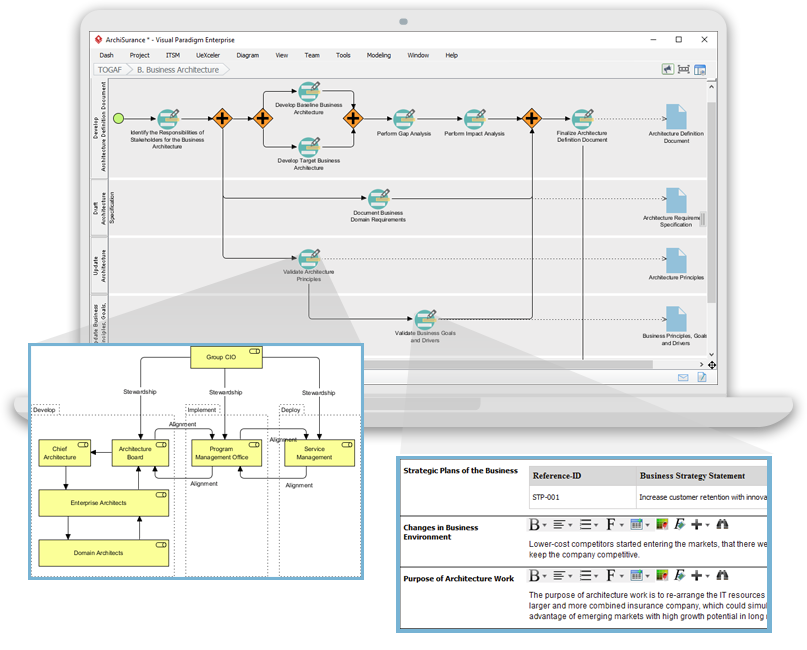Navigating TOGAF: Your Guide to the ADM Process
Introduction
The TOGAF (The Open Group Architecture Framework) is a comprehensive framework used by organizations worldwide to improve their business efficiency through effective enterprise architecture. While TOGAF offers a robust and structured approach to architecture development, it can sometimes seem daunting for organizations looking to adopt it without significant upfront training investment. Fortunately, there’s a solution – the Guided TOGAF ADM Process Map.
In this article, we will explore how the Guided TOGAF ADM Process Map can help organizations navigate the TOGAF Architecture Development Method (ADM) and produce all the necessary deliverables with ease, making the adoption of TOGAF more accessible and efficient.
Understanding the TOGAF ADM Process
The TOGAF ADM consists of several phases, each with a set of activities that need to be completed. These phases and activities provide a systematic approach to developing and managing enterprise architecture. However, for newcomers to TOGAF, understanding and implementing these phases and activities can be challenging.

The Guided TOGAF ADM Process Map simplifies this process by providing a step-by-step guide through each phase of the ADM. Let’s break down how it works:
-
Walk Through the ADM Phases
- The first step involves walking through the ADM phases using the TOGAF ADM navigator. This provides an overview of the entire architecture development process, from Preliminary Phase to the Requirements Management Phase and beyond.
-
Understand the Activities
- Within each phase, there are multiple activities to be completed. These activities are crucial for producing the required architecture deliverables. The Guided TOGAF ADM Process Map includes a visual representation of these activities, making it easier to grasp what needs to be done.
-
Perform the Actions
- For each activity, the map offers guidance on the specific actions that need to be taken. These actions may involve drawing diagrams (such as Spider charts for Capability Analysis) or filling out forms (like the Request for Architecture Work). The guidance ensures that you know exactly what to do at each step.
Automated Deliverable Generation
One of the most significant advantages of the Guided TOGAF ADM Process Map is that it automates the generation of architecture deliverables. As you progress through each phase and activity, your work is automatically transformed into deliverable format. This means that you don’t have to spend additional time formatting documents or reports – it’s all done for you.
Exporting as TOGAF ADM Deliverables
Once you have completed the necessary activities and generated the architecture deliverables, the Guided TOGAF ADM Process Map allows you to export these deliverables in TOGAF ADM format. This ensures that your architecture artifacts are compliant with TOGAF standards and can be easily shared with stakeholders, reviewed, and integrated into your organization’s architecture repository.
Benefits of Using the Guided TOGAF ADM Process Map
- Reduced Training Investment: Organizations can significantly reduce the upfront training investment required to adopt TOGAF. The guided process simplifies the learning curve, making it more accessible to architecture teams.
- Improved Efficiency: The automation of deliverable generation saves valuable time and reduces the risk of errors that can occur when manually formatting documents.
- Consistency: The guided approach ensures that architecture development follows a consistent and standardized process, leading to better-quality architecture artifacts.
- Enhanced Collaboration: With a clear and structured process, cross-functional teams can collaborate more effectively on architecture projects, aligning their efforts with the organization’s goals.
- Compliance: By following the guided process, organizations can be confident that their architecture artifacts align with TOGAF standards, increasing their credibility and trustworthiness.
Conclusion
The Guided TOGAF ADM Process Map offers a unique and innovative solution for organizations looking to adopt TOGAF without the burden of extensive upfront training. It simplifies the entire architecture development process, from understanding the phases and activities to automating the generation of architecture deliverables. By following this guided approach, organizations can streamline their architecture development efforts, enhance collaboration, and ensure compliance with TOGAF standards, ultimately leading to more effective and efficient enterprise architecture.

